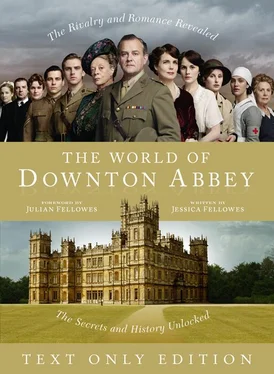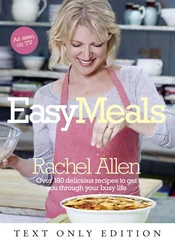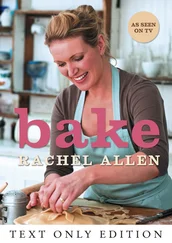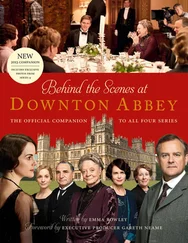My own great-aunt Isie, the model for Violet Grantham, was born in 1880, making her more than ten years older than Lady Mary Crawley, and she would die at ninety one in 1971, so I knew her well. She was one of the generation of young ladies who never went to school and her Mama would only allow her to attend university lectures in London if she agreed to two conditions: the first that she would never sit an exam, the second that she would be accompanied at all times by a maid. She was presented in 1898, married before the First World War and set up house in one of the Cadogans, ‘quite near Peter Jones, dear,’ with a butler who had been first footman to Mrs Willie James, reputedly the illegitimate daughter of King Edward VII. She lost her husband in the first war, her only son in the second, and she would live to see men land on the moon. From knowing her and listening to her story, a clear sense came to me that ‘history’ is not so long ago.
For most of them, the way of life lived at Downton would come to an end in 1939. Of course there would be people after the war who employed butlers and cooks, there are quite a few of them now, but as a way of life lived, to a degree, in every village and hamlet from Land’s End to John o’Groats, it was over. Many of the houses were requisitioned by the services, some to their cost, and the debts and mortgages accumulated since the collapse of the agricultural economy in the 1880s and 90s, made the idea of re-opening them when the fighting ended six years later, unalluring. Their renaissance would not come for thirty years or so after the Second World War and then, as I have said, the new owners chose to live in them differently. Happily, this revival has, in many cases, proved successful and Britain’s old families have written and continue to write another chapter in their long history. Which brings us back to the Crawleys of Downton Abbey, but when it comes to how far we will travel with them through the decades of challenge and change that lie ahead for their civilisation, that must remain to be seen.
Julian Fellowes
July 2011
Family Life CHAPTER ONE Family Life Society Change Life in Service Style House & Estate Romance War Behind the Scenes CAST LIST FURTHER READING ACKNOWLEDGEMENTS Copyright About the Publisher Конец ознакомительного фрагмента. Текст предоставлен ООО «ЛитРес». Прочитайте эту книгу целиком, купив полную легальную версию на ЛитРес. Безопасно оплатить книгу можно банковской картой Visa, MasterCard, Maestro, со счета мобильного телефона, с платежного терминала, в салоне МТС или Связной, через PayPal, WebMoney, Яндекс.Деньги, QIWI Кошелек, бонусными картами или другим удобным Вам способом.
April 1912.
The sun is rising behind Downton Abbey, a great and splendid house in a great and splendid park. So secure does it appear that it seems as if the way of life it represents will last for another thousand years.
It won’t.
Welcome to the world of Downton Abbey, a place that has captivated an audience of millions, all following the lives of one family and their servants. Against the backdrop of a fading Edwardian society, we watch their personal dramas unfold and see them through the horrors and change that the First World War brought to Britain. This perhaps is what fascinates us: not just the beautiful scenery, the sumptuous costumes, nor even the skill of the actors, but the fact that we are experiencing something of how life was a hundred years ago. We notice the differences between our lives and theirs; the rigid social hierarchy, the nuances of etiquette, the stifling clothes and the battle for women to be heard. But alongside this, we see something that is the same: family life.
At the forefront of everything at Downton is family, whether this stands for the blood ties of the Crawleys or the relationships between the servants below stairs. All of us can recognise a familiar character amongst them: Violet, the dowager Countess, the old-fashioned grandmother; Mary, Edith and Sybil, the squabbling sisters; Robert and Cora, the loving parents; or Rosamund, the interfering sister-in-law. Any of us who have left behind our families to make our own new, adopted ties with those we work with or with friends we choose are creating a new family, just as the servants do at Downton. With Carson and Mrs Hughes as the firm but fair parents, Thomas and O’Brien as the scheming siblings and Daisy as the baby, the servants are close by on the other side of the green baize door that separates upstairs and downstairs. Thrown together in cramped quarters, working long, hard hours, the servants nevertheless find security in their relationships with each other. Like all families, they have their ups and their downs, their favourites and a few petty fights.
Downton Abbey is more than just a house, it is also a home to both the family and the servants. Everyone living here is striving to keep the house and estate in good order, ready to pass on to the next generation. So when the question is raised of who will inherit, everyone is affected – above and below stairs. Even a miniature kingdom needs to know who is king.
For the moment, of course, Robert, the Earl of Grantham, is still the master of his realm. In this role, he has his own duties to fulfil just as much as Daisy, the scullery maid at the very bottom of the pecking order. A place like Downton Abbey cannot run well unless everyone within it understands their role and carries out their work efficiently.
There is a clear hierarchy at Downton; each servant has a position. The maids deal with the laundry, but the finishing of the clothes for the master and mistress of the house is the responsibility of Bates, valet to Lord Grantham, and Miss O’Brien, lady’s maid to Lady Grantham. These servants enjoy senior roles in the household, are two of the few that move seamlessly between below stairs and above, and enjoy the confidence of their employers. The rest of the staff probably think that these two have easier daily routines than the other servants, having nothing more to attend to than the earl and his wife’s needs. But from the first cup of tea brought up in the morning to whatever they might want last thing at night, they must be on duty all day with little respite. Their relationship with their employers is one of trust and practicality: Bates and O’Brien are welcome in the bedrooms, dressing rooms and even the bathrooms of their employers, making them privy to many details of the family’s private lives, and giving them a powerful position in the household. They could use this to their advantage when back downstairs, teasing or threatening the other staff with it – as when O’Brien learns before anyone else that the heir to Downton Abbey has been drowned during the Titanic disaster.
By contrast, the housemaids – Anna, Ethel, Gwen and Daisy – work behind the scenes. They are up early to complete the dusting of the drawing room and libraries, the plumping of the cushions, the cleaning of the grates and the laying of the fires before the family comes downstairs for breakfast. Only when the bedrooms are empty do the maids go in, to change the sheets and refresh the biscuit jars and water carafes. The rest of the day is spent on cleaning tasks set by the housekeeper, Mrs Hughes, such as beating rugs or polishing brass, as well as assisting the daughters of the house or any female guests who come to stay without their maids. They can be called upon at any time; each room in the house has a cord, pulled to summon assistance. The cord is connected to a wire that rings one of many bells on a board in the servants’ hall below; each labelled with the relevant room so the appropriate servant can attend. The jangle of bells is a sound that rules the servants’ lives.
Читать дальше











![Brian Thompson - A Monkey Among Crocodiles - The Life, Loves and Lawsuits of Mrs Georgina Weldon – a disastrous Victorian [Text only]](/books/704922/brian-thompson-a-monkey-among-crocodiles-the-life-thumb.webp)
